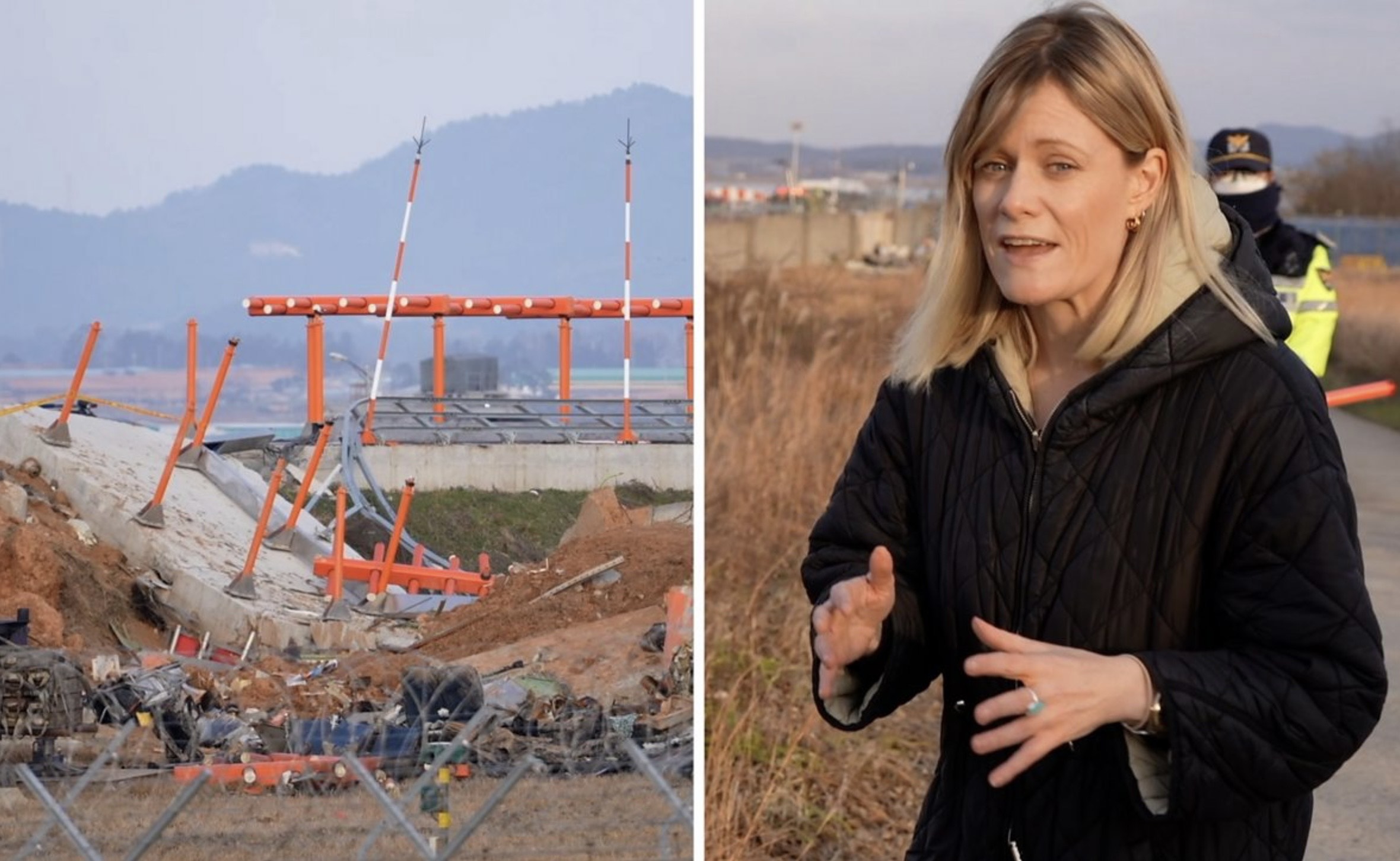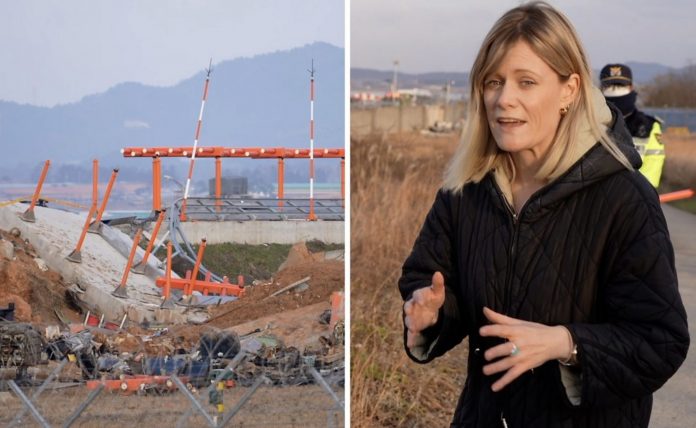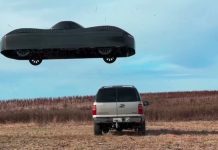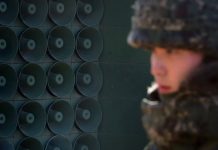ผู้เชี่ยวชาญด้านการบินได้ตั้งคำถามถึงความผิดปกติของกำแพงคอนกรีตที่ตั้งอยู่ใกล้กับรันเวย์ และบทบาทของมันในอุบัติเหตุเครื่องบินตกในเกาหลีใต้ ซึ่งคร่าชีวิตผู้คนไป 179 ราย เหตุเกิดขึ้นเมื่อวันอาทิตย์ที่ผ่านมา ที่ท่าอากาศยานนานาชาติมูอัน โดยภาพวิดีโอแสดงให้เห็นเครื่องบินของสายการบินเจจูแอร์ออกจากรันเวย์แล้วชนกำแพงจนเกิดไฟลุกไหม้
เจ้าหน้าที่กำลังสืบสวนสาเหตุของเหตุเครื่องบินตกครั้งร้ายแรงที่สุดในประวัติศาสตร์การบินของเกาหลีใต้ โดยกำลังพิจารณาถึงตำแหน่งของกำแพงคอนกรีตดังกล่าว ซึ่งอยู่ห่างจากปลายรันเวย์ประมาณ 250 เมตร (820 ฟุต) เดวิด เลียร์เมาต์ ผู้เชี่ยวชาญด้านความปลอดภัยทางการบินชี้ว่า หากไม่มี “สิ่งกีดขวาง” นี้ เครื่องบินอาจหยุดได้โดยมีผู้รอดชีวิตเกือบทั้งหมด
นักบินรายงานว่า เครื่องบินได้ชนกับนกก่อน จากนั้นจึงตัดสินใจยกเลิกการลงจอดครั้งแรกและขออนุญาตนำเครื่องบินลงในทิศทางตรงข้าม เครื่องบินกลับมาสู่รันเวย์ในระยะที่ไกลออกไปตามความยาวรันเวย์ 2,800 เมตร และดูเหมือนว่าจะร่อนลงโดยไม่ได้ใช้ล้อหรือชุดลงจอดใด ๆ
นายเลียร์เมาต์อธิบายว่า การลงจอดแบบ “ไม่มีชุดลงจอดหรือแฟลป” ทำได้ดีพอสมควร “ปีกอยู่ในระดับ น้ำหนักหัวเครื่องไม่สูงเกินไปจนทำให้หางหัก” และเครื่องบินไม่ได้รับความเสียหายมากในขณะไถลไปบนรันเวย์ แต่ “สาเหตุที่มีผู้เสียชีวิตจำนวนมาก ไม่ใช่เพราะการลงจอดโดยตรง แต่เป็นเพราะเครื่องบินชนเข้ากับกำแพงแข็งอย่างรุนแรงหลังหลุดจากปลายรันเวย์” เขากล่าว
กัปตัน รอสส์ ไอม์เมอร์ ประธานเจ้าหน้าที่บริหารของบริษัทที่ปรึกษา Aero Consulting Experts ให้สัมภาษณ์กับสำนักข่าวรอยเตอร์ว่า “น่าเสียดายที่กำแพงคอนกรีตนั่นคือเหตุผลที่ทำให้มีผู้เสียชีวิต เพราะเครื่องบินชนโครงสร้างคอนกรีตโดยตรง ซึ่งไม่ควรมีสิ่งนี้อยู่ตรงนั้น” ขณะที่คริสเตียน เบกเคิร์ต นักบินจากสายการบินลุฟท์ฮันซ่า ในมิวนิกระบุว่า “โดยปกติแล้ว บริเวณท้ายรันเวย์ในสนามบินจะไม่มีผนังแบบนี้อยู่เลย”
สำนักข่าวยอนฮัป รายงานว่ากำแพงคอนกรีตดังกล่าวเป็นโครงสร้างสำหรับรองรับระบบนำร่องการลงจอดซึ่งช่วยนำทางเครื่องบิน ระบบนี้มีความสูง 4 เมตร และถูกกลบด้วยดินบางส่วนเพื่อให้ตำแหน่งของอุปกรณ์อยู่ในระดับเดียวกับรันเวย์ ทั้งนี้ กระทรวงคมนาคมเกาหลีใต้ชี้ว่าในสนามบินอื่น ๆ ทั้งในประเทศและต่างประเทศก็มีติดตั้งอุปกรณ์ลักษณะเดียวกัน อย่างไรก็ตาม เจ้าหน้าที่จะตรวจสอบว่าควรใช้วัสดุที่เบาและแตกหักได้ง่ายกว่าหรือไม่
คริส คิงส์วูด นักบินประสบการณ์ 48 ปีที่เคยขับเครื่องบินรุ่นเดียวกับเครื่องบินที่ตก ให้สัมภาษณ์กับ BBC News ว่า “สิ่งกีดขวางที่อยู่ใกล้รันเวย์ขนาดนี้ต้องเป็นวัสดุที่แตกหักได้ หากเครื่องบินชน เพื่อให้โครงสร้างสลายตัวลง ไม่ทำให้เกิดอุบัติเหตุร้ายแรง แต่ที่เห็นนี้ดูแข็งมาก เครื่องบินเองถูกออกแบบให้มีน้ำหนักเบาเพื่อให้บินได้มีประสิทธิภาพ ไม่ได้ออกแบบให้วิ่งด้วยความเร็วสูงบนท้องเครื่อง จึงเกิดการฉีกขาดบริเวณลำตัวเครื่องได้ง่าย เมื่อปีกแตกก็ทำให้เชื้อเพลิงรั่วไหลและเสี่ยงต่อการเกิดไฟลุกไหม้”
อย่างไรก็ดี คิงส์วูดกล่าวว่าเขารู้สึก “แปลกใจ” หากสนามบินไม่เป็นไปตามข้อบังคับด้านอุตสาหกรรมการบินทั้งหมด เพราะในสนามบินขนาดใหญ่หลายแห่งก็อาจพบสิ่งกีดขวางในลักษณะเดียวกันได้เช่นกัน ด้านจอห์น ค็อกซ์ อดีตนักบินและประธานเจ้าหน้าที่บริหารของ Safety Operating Systems ให้ความเห็นต่างว่า รันเวย์ดังกล่าว “ไม่เป็นไปตามมาตรฐานที่ดีที่สุดของอุตสาหกรรม” เพราะไม่ควรมีโครงสร้างแข็งอยู่ภายในระยะ 300 เมตรจากปลายรันเวย์
ภายหลังอุบัติเหตุ มีรายงานว่าในคู่มือปฏิบัติงานสนามบินนานาชาติมูอันที่ถูกอัปโหลดตั้งแต่ช่วงต้นปี 2024 ระบุไว้ว่ากำแพงคอนกรีตแห่งนี้ตั้งอยู่ใกล้ปลายรันเวย์เกินไป เอกสารจากบริษัท Korea Airports Corp เสนอให้มีการทบทวนตำแหน่งของอุปกรณ์ดังกล่าวระหว่างการขยายสนามบินที่วางแผนไว้ ขณะที่คิม ฮง-รัก ผู้อำนวยการใหญ่ฝ่ายนโยบายสนามบินของเกาหลีใต้ เปิดเผยว่า รัฐบาลจะ “ทบทวนกฎระเบียบและการบังคับใช้ที่เกี่ยวข้อง” อีกครั้ง
ซัลลี เกทิน นักวิเคราะห์ด้านการบินตั้งข้อสงสัยว่านักบินรับรู้หรือไม่ว่ามีกำแพงอยู่ในตำแหน่งดังกล่าว โดยเฉพาะอย่างยิ่งเมื่อเครื่องบินเข้ามาทางรันเวย์ในทิศทางตรงข้ามกับการลงจอดปกติ “เราต้องการทราบว่าพวกเขาทราบถึงสิ่งกีดขวางแข็งนี้หรือไม่ หากหอควบคุมการบินเป็นผู้สั่งให้เปลี่ยนทิศทางรันเวย์ในครั้งที่สอง เราจะทราบคำตอบได้จากการตรวจสอบกล่องดำ” เธอกล่าว พร้อมย้ำว่า “ยังมีอีกหลายคำถามที่ต้องหาคำตอบ”
ในการแถลงข่าวเมื่อวันอังคาร คิม อี-แบบ ประธานเจ้าหน้าที่บริหารของเจจูแอร์ ปฏิเสธที่จะให้ความเห็นโดยตรงเกี่ยวกับกำแพงคอนกรีต เมื่อผู้สื่อข่าวถามว่าเขาคิดว่ากำแพงเป็นปัจจัยที่ทำให้เกิดโศกนาฏกรรมครั้งนี้หรือไม่ เขาเพียงกล่าวว่าถูกต้องแล้วที่จะเรียกเหตุการณ์นี้ว่า “โศกนาฏกรรมเจจูแอร์” มากกว่าจะเรียกว่า “โศกนาฏกรรมสนามบินมูอัน”
Why was there a wall near the runway at S Korea plane crash airport?

Aviation experts have raised questions about an “unusual” concrete wall near the runway and its role in the South Korea plane crash that killed 179 people.
Footage shows the Jeju Air plane coming off the runway before colliding with the wall and bursting into flames at Muan International Airport on Sunday.
Authorities investigating the cause of South Korea’s worst-ever plane crash are considering the significance of the concrete wall’s location about 250m (820ft) off the end of the runway.
Air safety expert David Learmount said that, had the “obstruction” not been there, the plane “would have come to rest with most – possibly all – those on board still alive”.
The pilot reported that the plane had struck a bird and then aborted the original landing and requested permission to land from the opposite direction.
The plane came down some distance along the 2,800m runway and appeared to land without using its wheels or any other landing gear.
Mr Learmount said the landing was “as good as a flapless/gearless touchdown could be: wings level, nose not too high to avoid breaking the tail” and the plane had not sustained substantial damage as it slid along the runway.
“The reason so many people died was not the landing as such, but the fact that the aircraft collided with a very hard obstruction just beyond the runway end,” he said.
Another aviation analyst agreed. Captain Ross Aimer, chief executive of Aero Consulting Experts, told Reuters news agency: “Unfortunately, that thing was the reason that everybody got killed, because they literally hit a concrete structure. It shouldn’t have been there.”
Christian Beckert, a Lufthansa pilot based in Munich, called the concrete structure “unusual”, saying: “Normally, on an airport with a runway at the end, you don’t have a wall.”
The concrete structure holds a navigation system that assists aircraft landings – known as a localiser – according to South Korea’s Yonhap News Agency.
At 4m high, it is covered with dirt and was raised to keep the localiser level with the runway to ensure it functions properly, Yonhap reported.
South Korea’s transport ministry has said that other airports in the country and some overseas have the equipment installed with concrete structures. However officials will examine whether it should have been made with lighter materials that would break more easily upon impact.
Chris Kingswood, a pilot with 48 years’ experience who has flown the same type of aircraft involved in the crash, told BBC News: “Obstacles within a certain range and distance of the runway are required to be frangible, which means that if an aircraft strikes them that they do break.
“It does seem unusual that it’s such a rigid thing. The aircraft, from what I understand, was travelling very fast, landed a long way down the runway, so it will have gone a long way past the end of the runway… so where will you draw the line with that? That’s certainly something that will be investigated.
“Aeroplanes are not strong structures – they are, by design, light to make them efficient in flight. They’re not really designed to go high-speed on its belly so any kind of structure could cause the fuselage to break up and then be catastrophic.
“The fuel is kept in the wings so once the wing ruptures, then the potential for fire is significant.
“So it’s not a given that if the wall had not been there, it would have been a completely different outcome.”
Mr Kingswood said he would be “surprised if the airfield hadn’t met all the requirements in accordance with industry standards”.
“I suspect if we went around the airfields at a lot of major international airports… we would find a lot of obstacles that could similarly be accused of presenting a hazard,” he added.
However former pilot John Cox, chief executive of Safety Operating Systems, said the runway design “absolutely (did) not” meet industry best practices, which preclude any hard structure within at least 300m (984ft) of the end of the runway.
Following the crash, it emerged that remarks in Muan International Airport’s operating manual, uploaded early in 2024, said the concrete embankment was too close to the end of the runway.
The document, prepared by Korea Airports Corp, recommended the location of the equipment be reviewed during a planned expansion.
South Korea’s director-general for airport policy, Kim Hong-rak, said the government would “review the relevant regulations and their application”.
Aviation analyst Sally Gethin questioned whether the pilot knew the barrier was there, particularly given the plane was approaching from the opposite direction from the usual landing approach.
She told BBC News: “We need to know, were (the pilots) aware there was this hard boundary at the end?
“If they were directed by the control tower to reverse the use of the runway the second time around, that should come out in the investigation of the black boxes.”
“I think there are so many questions.”
At a news conference on Tuesday, Jeju Air’s chief executive Kim Yi-bae would not be drawn when asked about the concrete wall.
Asked by a reporter if he thought the wall was a factor in the disaster, he did not give a direct answer and instead said it was right to call the plane crash the Jeju Air disaster, rather than the Muan Air disaster.
By David Mercer, BBC

















